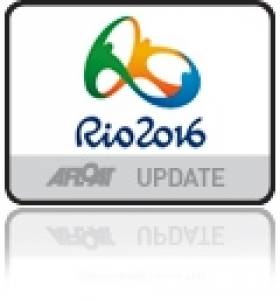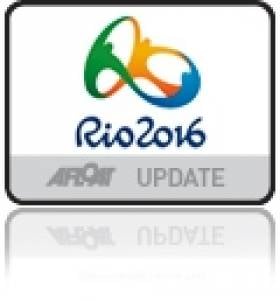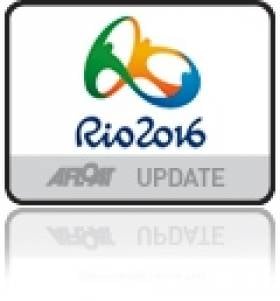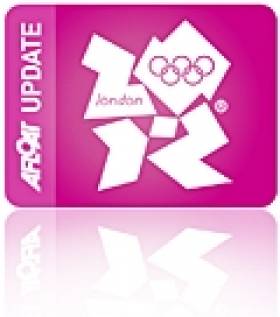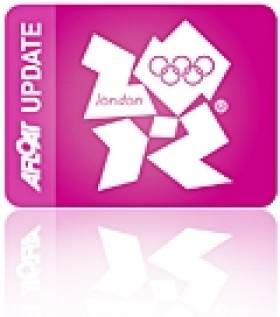Displaying items by tag: Star
Brazilian Government Move to 'Reinsert' Star Keelboat for Rio 2016 Olympic Regatta
#star – The President of Brazil, Dilma Rousseff, has moved to have the Star keelboat reinstated as an Olympic class at the 2016 Olympic Games in Rio de Janeiro.
Brazilian ambassadors from around the world are seeking support from nations to help them reinsert the oldest and most traditional class back in to the Games in three years time.
The legendary class lost its status after a controversial decision by the world body of sailing, ISAF in 2011. It was thought that the venerable 100–year–old design sailed its last Olympic regatta at London 2012 but now there is new hope for the much loved craft.
In a letter from the Embassy of Brazil, date January 16th and seen by Afloat.ie, the Brazilian Government says it firmly endorses the request noting that out of the 18 sailing medals Brazil has won, six were in the Star class.
The embassy says the new ISAF president Carlos Croce, has already 'requested to the International Olympic Committee (IOC) the inclusion of an 11th sailing class in the next games to accomodate the Star'.
The letter outlines the minimal additional budgetary cost involved and how it would 'strongly contribute to strengthening the positive spirit surrounding this unprecedented event held in in Brazil'.
It is expected the matter will come before the next meeting of the executive committee of the IOC to be held in Sochi on February 2.
Last July, Afloat reported that Brazil had still to make up its mind to back the boat.
Bahamas To Host First Ever Star Sailors League Final
#Star - The Star Sailors League (SSL) has announced its first ever event in the 2013 SSL Final, an invitational event from 3-8 December at the Nassau Yacht Club in the Bahamas with the best Star sailors from 11 countries competing for US$200,000 in prize money.
The provisional entry list - which includes three Olympic gold medallists, 11 Olympic class world champions and a Louis Vuitton Cup winner - represents the first and the only time, after the Star Worlds and 2012 Olympic Games, that so many international Star champions will race together.
Most of the leaders in the SSL Ranking list have already confirmed their participation, and include Robert Scheidt (BRA), Xavier Rohart (FRA), Freddy Loof (SWE), Eivind Melleby (NOR), Michael Hestbaek (DEN), Flavio Marazzi (SUI), Johannes Polgar (GER), Robert Stanjek (GER), Mateusz Kusznierewicz (POL), George Szabo (USA) and Diego Negri (ITA).
Also confirmed is US sailor Paul Cayard, long time Star sailor and 1992 Louis Vuitton Cup Winner, who will compete as a welcome guest. Further participants will be confirmed.
This event will also be the first Star Class event with the new race format - for all 18 boats, regatta style racing for three days, with no more than four races per day and a maximum of nine races in all - followed by an innovative fourth day whereby the top ten from the previous days will compete in the three final races with a progressive drop-out of three boats per session.
The last day of racing will begin with 10 boats in the quarter final, seven in the semi-final and only four in the final. The overall winner of the event will be the team that first crosses the line in the final race, and will receive 4,000 SSL points.
Prizes include the Best Skipper of the Year award, while the Best Crew of the Year will receive the first Simpson Memorial Trophy in memory of British Star sailor Andrew 'Bart' Simpson who tragically lost his life in training for the America's Cup this summer.
All races will be broadcast live on the official website www.starsailors.com with Virtual Eye technology, the same tracking that was used during the America’s Cup.
And virtual engaging doesn't stop here, as sailors from all over the world will be invited to 'play' the Star Sailors League with Virtual Regatta INSHORE.
The SSL has partnered with online gaming company Many Players to develop this unique event. As Many Players CEO Philippe Guigné explains: "We're happy to work with the Star Sailors League and offer the opportunity to play before, during (live) and after this event to all our one million players.
"Here we are making a new step, for the first time on the INSHORE game offering the magnificent Star boats and the unique SSL ranking system."
The inaugural Grand Final will officially launch the SSL's activities, and with five days of competition will put the emphasis on men rather than machines.
The Star Sailors League was established last January, the birth of a dream of Olympic and amateur sailors to build an international regatta circuit to promote athletes and their skills.
Under the SSL name the organisation brings together all the Star Class regattas and defines a new world ranking, based on the model of the ATP World Tour created by tennis players in 1972, with more than 2,400 skippers and crew already ranked in the SSL Ranking.
Drawing its inspiration from tennis and its annual Masters, the SSL Board is launching the Star Sailors League Final which will be sailed at the end of each year.
British School Children to Create Star Sails
#star – 28,000 UK schools and every child in the country have been offered the opportunity to create fine art for Olympic Star Class sails.
Fine Art Sails and the Andrew Simpson Sailing Foundation are inviting young people from 8 to 17 years of age to jump aboard and enter into a unique competition to design a 10m tall main sail for a 'Star Class' boat to be raced by Sir Ben Ainslie, Iain Percy OBE and many more Olympic sailors at the London Boat Show on 4th and 5th January 2014.
The 'Sail Art' contest is supported by The Campaign for Drawing led by the Serpentine Gallery Founding Director Sue Grayson-Ford. The Campaign's Patrons include Andrew Marr, Sir Quentin Blake, and David Hockney CM.
The competition for the best artwork for the Olympic sails is in three categories - 8-11 years; 12-14 years; 15-17 years.
The theme is 'Legends of the Sea' intended to unleash imaginations and art materials. Students are to think about sea gods, mythical marine creatures, Atlantis or any windy and watery shanties that take their fancy.
The first prizes will also include a day sailing with Olympic sailors, STAEDTLER art materials worth £250 for the winning schools, and a special invitation to the London Boat Show in January 2014 to watch the Fine Art Sails regatta on 4th and 5th January 2014.
As well as the 3 winning student artworks (one winner from each age group) being hoisted onto Olympic Star Class sails for the regatta, 3 new established artists' work will join 4 sails from last year's regatta by Goldie, Julian Opie, David Begbie and EINE.
Discussing the National Schools "Sail Art" Competition, Olympic Gold medallist Iain Percy OBE says: "One of the things I really love about sailing, is the ocean. The beauty of it. The power of it sometimes. I want young people in this sailing art competition to capture it for us".
Americas Cup winner and Olympic Gold medallist Sir Ben Ainslie says: "Sailing is a fantastic sport in many ways but not just on the water. It's a way youngsters can express themselves. The sail is a great canvas for kids to paint all over and express themselves in different ways. I'm very excited about that".
Founder of Fine Art Sails Michael Ross says: "My idea with this competition is to let every child in the country know about sailing, not just as a sport but as a potential career path. Not every school has sailing as an activity, but every child in the country has art lessons. This competition will bring sailing into every child's art class".
Fine Art Sails and the National Schools "Sail Art" Competition is in support of the Andrew Simpson Sailing Foundation (ASSF).
http://www.campaignfordrawing.org/competitions/sailart.aspx
http://www.andrewsimpsonsailing.org/getsailing.php
After Andrew Simpson's tragic death, the Foundation was established by Iain Percy OBE, Sir Ben Ainslie, and Andrew's wife Leah. The Fine Art Sails National Sail Art Competition continues the theme of encouraging and mentoring children into sailing, honouring Andrew's life and legacy.
Through their sailing experiences the charity will help to develop young people's life skills, but importantly it will also assist the children into employment in the sailing community through apprenticeships with partners including sail makers, boat builders, nautical technologies and other marine companies.
#rio – Although a decision isn't expected this summer, attention from the event has led to speculation the former Star class sailboats will be reinstated for the 2016 Summer Olympics in Rio, Brazil.
The Star class' governing body is stating the earlier news of the event's reinstatement in the 2016 Olympics is "still just a rumour." Star class sailing was removed from the 2016 Olympics line-up in May 2011.
International Star Class Yacht Racing Association president Bill Allen said in a statement that Brazil's Olympic committee "may request an 11th medal for sailing" but no decision was made and probably won't be until this summer at the earliest. He will keep Star class members informed of new developments, Allen said.
The source of the speculation might be that Brazil's Robert Scheidt won the 2011 and 2012 World Championships in the Star class along with the silver medal at 2008's Beijing Olympics and the bronze medal at 2012's London Olympics.
The reports on various U.S. websites state International Olympic Committee regulations allow the host country to add one event of its choosing if the country itself picks up the tab. However, Allen says that is not accurate.
Since it debuted at the 1932 Olympics in Los Angeles, the Star class has been absent from only one Olympics, Montreal in 1976. It was dropped prior to the 2000 Olympics in Sydney but then reinstated.
The Star class often is called "the fleet of champions" because many Olympic and world championship sailors finish their careers in that class of boat.
The inaugural CNM Estates UK Star Championships was held 18-20 January in cold and snowy conditions. Xavier Rohart of France and Serge Pulfer of Switzerland took the gold medal with 17 points.
The winners were presented with the Royal Thames Yacht Club "Fine Art Sails Regatta" by Admiral Sir Mark Stanhope.
The team of Max Treacy and Anthony Shanks of Ireland finished second with 35 points while Andrew Simpson and Iain Percy of Great Britain totalled 37 points for third place in the event, held in the waters of the Royal Victoria Docks outside London's ExCeL exhibition centre.
Other cities that have expressed interest in holding their own Fine Art Sails event are Moscow, San Francisco, Auckland, Stockholm and Baku, the capital of Azerbaijan and largest city on the Caspian Sea.
The event attracted top international sailors, including many European and World title holders. They included triple Olympic medallist Iain Percy, double Olympic medallist Andrew Simpson, Beijing gold medallist Pippa Wilson, London silver medallists Luke Patience and Stuart Bithell, and Athens bronze medallist Xavier Rohart.
The mainsails were unique pieces of art created by internationally famous artists such as: Julian Opie, EINE, Jaime Gili, INSA, Eley Kishimoto, Wendy Taylor, Christian Furr, David Begbie, Pam Glew and Goldie.
"This is a totally new venue for artists to display their work. It's an opportunity to show off their artwork to the public and reach an audience they haven't reached before," Ross said.
Ireland's 'Spiced Beef', Peter O'Leary's Star keelboat, finished eighth overall at the Bacardi cup in Miami, Florida at the weekend with a disappointing 27th scored in the penultimate race pushing the Cork man, sailing with Rodney Hagebols, out of overall contention in the 55-boat fleet.
O'Leary won the fourth race of the series in big breeze but failed to capitalise on this win in the latter half of the series that ended on Friday.
With points tight among the top contenders the big story of the regatta was the win of the 86th Bacardi Cup by the Florida team of Mark Mendelblatt (St. Petersburg) and Brian Fatih (Miami). Having started their series on Monday by picking up the max number of points for an over early start, the duo worked their way back up the standings to end the penultimate day of the series in second overall.
"We started [the series] not in the best way, but we turned it around," said Mendelblatt, who previously won the Bacardi Cup in 2005. "It was a disappointing start and it was my fault for not having a good first race. After that we've been very consistent with low scores. We won the last two races and everything went our way. Winning the Cup again means a lot to me; it's really great because winning any big Star regatta is not easy at all! I am very happy to have had Brian with me. He is a great crew and wanted to have his name on the Tito Bacardi trophy. The Bacardi Cup is a great event and now, with the addition of all the other classes, it's even more satisfying."
Mendelblatt and Faith, who represented the USA in the Star class at the 2012 Olympics, won the single race contested by the 56 Star teams on the final day of the series to move to the top of the standings with 26 points.
Lars Grael and Mario Lagoa (BRA), who had been atop the overall standings throughout the week, took second overall with 30 points after placing seventh in the race. Defending champion Xavier Rohart (FRA) ended the series tied on points with Grael after finishing the race in fourth place to take third in the overall standings. The only change for Diego Negri and Frithjof Kleen (ITA) or 2003 Rolex Yachtsman of the Year Augie Diaz (Miami, Fla.) and Arnis Baltins, was in the point totals as both retained their positions in the top-five with, respectively, 33 and 41 points.
Class results here
O'Leary & Burrows Could Go For Gold In Rio as Star 'Secures A Slot' UPDATED
UPDATE: The governing body for the Star class is reporting that the earlier news of its reinstatement in the Olympics for 2016 is still "just a rumour".
In a statement, International Star Class Yacht Racing Association (ISCYRA) president Bill Allen said that while the Olympic committee in Brazil "may request an 11th medal for sailing", no decision has yet been made and likely will not be made until summer at the earliest.
"The spreading of rumours concerning Olympic status does not help our position," he added, saying he would inform Star class membership with any new developments as and when they arise.
#Rio2016 - Ireland's Star sailors Peter O'Leary and David Burrows could have another shot at Olympic gold in Rio if the latest news from the IOC is to be believed.
Sailing Anarchy reports that "the ink is dry" on an agreement to secure a place for the Star class in the sailing schedule at the 2016 Olympic Games in Rio de Janeiro.
The move is thanks to a "quirk" in IOC regulations that allow the host country of any Olympic Games to add an event of their own choosing, provided the hosts cover the costs.
And with local sailing duo Robert Scheidt and Bruno Prada in the Star's top ranks - claiming the bronze in London 2012 - the return of the class certainly seems a no-brainer.
The only question remaining now is whether O'Leary and Burrows - who finished 10th in the class at Weymouth last summer - want to go for gold one more time in Rio!
O'Leary Let Off With Warning Over Beijing Bet
#OLYMPICS - Irish Olympic sailor and current All-Ireland sailing champion Peter O'Leary has been let off with a warning by officials after betting on a competitor to win at the 2008 Games in Beijing.
O'Leary and his then partner Stephen Milne did not qualify for the Star class medal race in Beijing, in which O'Leary won €3,600 after placing a €300 bet on 12-1 Britain.
The story came to light days before O'Leary and current teammate David Burrows began their Star class campaign at this summer's London Olympics, prompting an investigation by the International Olympic Committee (IOC).
But IOC chiefs announced yesterday that they had found "no proof of any match-fixing".
While Olympic athletes are banned from betting on Olympic events, the IOC's ethics commission agreed that O'Leary was not fully aware of the rules at the time.
"The athlete was unaware he could not bet on Olympic events," said IOC spokesperson Mark Adams. "It is not something we agree with and we condemn it but we will not take any more action."
O'Leary and Burrows finished 10th in the Star class at the London Games in what was a milestone summer for Irish sailing on world sport's biggest stage.
O'Leary and Burrows Prepare for Star Class Swan Song
#Star – There is disappointment for Ireland's Peter O'Leary and David Burrows because although they sail in tomorrow's Olympic medal race – a significant achievement in itself – they are not in contention for a medal. The Cork-Dubin duo who came together three years ago for a final assault in the mens keelboat will nevertheless compete in the final race of the Star as an Olympic keelboat. The famous design has been ditched from the 2016 regatta after 100 years of involvement in favour of kitesurfing. Any result achieved by the pair inside the top ten will be Ireland's best ever result in the class.
O'Leary and Burrows finished fleet racing yesterday in ninth place overall and with 75 points. Leaders Percy and Simpson (GBR) have 18 points, followed by Scheidt and Prada (BRA) on 26 points and Loof and Salminen (SEW) on 30 points.
In Friday's final fleet racing qualification for the medal race hinged on the two final races.
The pair rounding the first mark of Race 9 in 10th place. However, they were 14th rounding the second mark and just didn't manage to break the top 10 again finishing the race in 11th. Not letting that deter them, O'Leary and Burrows came out fighting in Race 10; the final fleet race. In the first leg they moved from 11th to 5th to eventually finish in 7th place, less than 90 seconds behind the leaders Percy & Simpson (GBR).
Irish Star Duo 'Disqualified' from Race Seven in Weymouth
#olympic sailing – Peter O'Leary and David Burrows have been disqualified (DSQ) from this morning's race seven of the Star Class Olympic regatta following a protest taken by Denmark's (DEN) Michael Hestbaek over an incident on the water between the Irish and Danish yachts.
According to a notice published by the protest jury tonight O'Leary has been disqualified from the race because he 'failed to give mark-room' to a boat overlapped inside of the Irish boat, breaking rule 18.2(b). The full jury decision is published on the official site here. (Scroll down to read the full jury decision below).
The jury found that during the first rounding of the windward mark, DEN and IRL were sailing on port tack, DEN to windward of IRL, with strong wind, waves and current. When DEN was within two boat lengths from the mark, the two boats luffed in order to tack. Shortly after passing head-to-wind the boats came close to each other. There was contact between the bow of IRL and the starboard quarter of DEN. The boats then bore down to close-hauled on starboard tack and sailed around the mark, with DEN in front. Neither boat was damaged, nor did they do penalty turns according to the jury.
On the water incidents between competing boats are a regular and normal part of sailing competition. A protest is a standard procedure to resolve disputes between competitors under the racing rules of sailing.

O'Leary and Burrows had a strong start in Race 7 this afternoon. Rounding the second mark they were in fourth, ahead of rivals Robert Scheidt and Bruno Prada (BRA) but while the Brazilians progressed to finish third, O'Leary and Burrows slipped back to finish in 9th but tonight this result has been changed to a DSQ.
In race 8 the Irish duo finished seventh.
O'Leary and Burrows now sit 9th overall on 51 points. Leaders Iain Percy and Andrew Simpson (GBR) are on 13 points while the Brazilians in second are on 22 points. The Star class have a final two fleet races tomorrow before the top 10 progress to the double points medal race on Sunday, 5th August.
In the 49er class Ryan Seaton and Matt McGovern, who have been sailing for four consecutive days, put in another solid performance to hold on to their spot as 9th overall on the leader board. They began Race 7 in 16th place but quickly moved up the ranks to finish just outside the top 10 in 11th. Race 8 saw them better themselves further, finishing a respectable 9th, which was enough for them to remain in 9th overall on 61 points. The Australians, Outteridge and Jensen, hold the lead on 24 points followed by Morrison and Rhodes (GBR) on 35 and Burling and Tuke (GBR) on 41. The 49er class will continue to race tomorrow before their well-earned rest day on Saturday.
Today was the long awaited first day of racing for the Irish 470 duo, Ger Owens, sailing at his third Olympics and Scott Flanigan. Flanigan is the youngest of the Irish sailors at just 19. They got off to a solid start holding position in the middle of the 27 boat fleet, working their way up to 15th during the middle of the race. They didn't quite manage to hold on to their spot and slipped back to finished 18th. They didn't fare as well in Race 2 finishing in 25thplace. They will continue sailing tomorrow, beginning the day in 23rd overall.
Today was the rest day for both the Laser Radial and the Laser fleets. Annalise Murphy remains in first overall and James Espey remains in 45th overall. Both classes will resume racing tomorrow.
Racing will continue tomorrow for all classes with a total of 11 races being sailed by Irish competitors. Sailing action starts at 12 noon in Weymouth.
Protest No. 34
Event: Star - Men
Race: 7
Protestor: DEN
Protestee: IRL
Protest details: Rule 18
Description:
Facts found:
Protestor represented by: Michael Hestbaek, protestee represented by Peter O"Leary
Notes on procedure: The protestee questioned validity, as the description of the incident was only a diagram with no text. The Jury found that there was enough information on the protest (time and location of incident, identity of protestor and protestee and diagram) to identify the incident as required by RRS 61.2(b)
During the first rounding of the windward mark, DEN and IRL were sailing on port tack, DEN to windward of IRL, with strong wind, waves and current. When DEN was within two boat lengths from the mark, the two boats luffed in order to tack. Shortly after passing head-to-wind the boats came close to each other. There was contact between the bow of IRL and the starboard quarter of DEN. The boats then bore down to close-hauled on starboard tack and sailed around the mark, with DEN in front. Neither boat was damaged, nor did they do penalty turns.
Conclusion:
By not giving room to tack to DEN overlapped to windward and on the inside of her, IRL failed to give mark-room to a boat overlapped inside of her, breaking rule 18.2(b). She also broke rule 14. DEN broke rule 13 by not keeping clear of IRL when both were subject to rule 13 as she was on IRL"s port side; however she is exonerated under rule 18.5(a). DEN didn"t break rule 14.
Rule(s) applicable:
13,14, 18.2(b), Definiton of mark-room
Decision:
IRL is disqualified from Race 7
Short decision:
IRL DSQ Race 7
Jury:
John Doerr, Francisco Jauregui, David de Vries, Nelson Ilha, Rut Subniran
#olympicsailing – In a perfect opening salvo Peter O'Leary and David Burrows are in silver medal position in the Mens keelboat class after two races in testing 16-20 knots winds at Weymouth today.
The Irish pair led both races of the Star class for a time and made a dramatic comeback in race one where they were 14th out of 16 for a time before a 15 degree left hand windshift moved them up from 13th to second, a fantastic opening result for the Irish campaign.
But right now everyone in the Irish camp is mindful that the focus must be very much sailing rather than premature celebrations. After all it's only day one with two gold medallist teams just a few points behind.
After racing Burrows said in terms of wind across the race track there was as much as five knots difference from one side of the course to the other making it essential for success to stay in the strongest breeze, a tough job in shifting winds.
In race two a plucky move nailed a mid line start and some incredible off the line boat speed put O'Leary/Burrows into first place on the opening beat, a position the Irish held until halfway down the first run when class supremos Iain Percy/Andrew Simpson of (GBR) and Robert Scheidt/Bruno Prada (BRA) overhauled them with some blistering downwind pace.
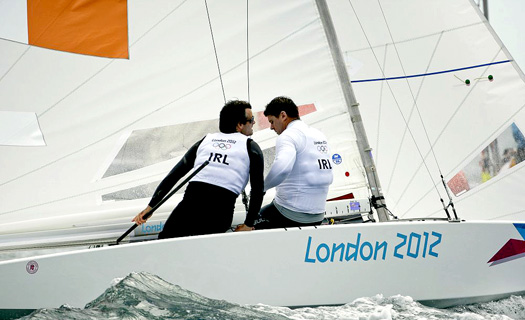
Peter O'Leary and David Burrows (IRL), competing today in the Men's Keelboat (Star) event in The London 2012 Olympic Sailing Competition. Photo: Onedition
A big left hand shift cost O'Leary five places at the second weather mark and put the pair as far back as eighth at one point. The pair fought back strongly though to be sixth by the finish and to put them into second place in the overall regatta standings tonight.
It was a photo finish in Race 2 as Robert Scheidt and Bruno Prada (BRA) overcame Iain Percy and Andrew Simpson (GBR) by the narrowest of margins.
Both teams finished in a time of 73:39 but the race win was awarded to the Brazilians as they took the overall lead having finished fourth in Race 1.
On the race Scheidt said, "We exchanged positions on the second beat, one passing the other all the time and it came down to the finish line. It was a very interesting race. It was so tight that it was hard to see if we won."
Percy and Simpson had a weak start to the competition finishing Race 1 in 11th place but they fought back and almost recorded a bullet in the second place. Simpson said, "It was a tricky race and a good battle at the front. It was very shifty out there and we learnt a few lessons from the first race. We thought we were ahead and it was unbelievably close.
Ireland's David Burrows and Peter O'Leary are second overall after a consistent day that included a second in Race 1 and sixth in Race 2. Meanwhile Mateusz Kusznierewicz and Dominik Zycki (POL) are third overall.
The Star event consists of 10 races and a medal race held between today and Sunday. Race Three gets underway tomorrow at 2.05pm.
Competition at the Games starts for three other Irish sailing campaigns tomorrow with Ryan Seaton and Matt McGovern in the 49er, James Espey in the Laser and Annalise Murphy in the Laser Radial class. Sailing actions starts at 12 noon.
Full results here
Live feeds for racing here






























